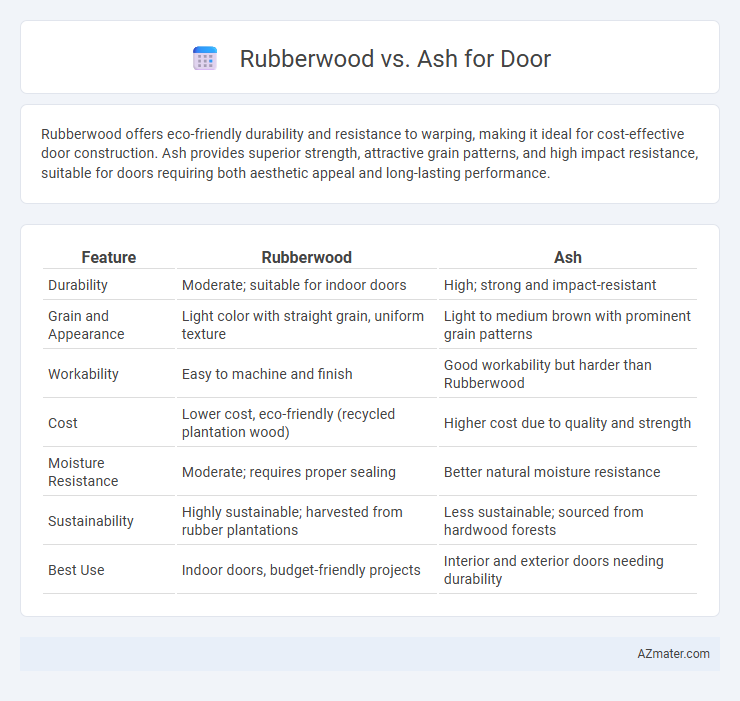Rubberwood offers eco-friendly durability and resistance to warping, making it ideal for cost-effective door construction. Ash provides superior strength, attractive grain patterns, and high impact resistance, suitable for doors requiring both aesthetic appeal and long-lasting performance.
Table of Comparison
| Feature | Rubberwood | Ash |
|---|---|---|
| Durability | Moderate; suitable for indoor doors | High; strong and impact-resistant |
| Grain and Appearance | Light color with straight grain, uniform texture | Light to medium brown with prominent grain patterns |
| Workability | Easy to machine and finish | Good workability but harder than Rubberwood |
| Cost | Lower cost, eco-friendly (recycled plantation wood) | Higher cost due to quality and strength |
| Moisture Resistance | Moderate; requires proper sealing | Better natural moisture resistance |
| Sustainability | Highly sustainable; harvested from rubber plantations | Less sustainable; sourced from hardwood forests |
| Best Use | Indoor doors, budget-friendly projects | Interior and exterior doors needing durability |
Introduction: Comparing Rubberwood and Ash for Doors
Rubberwood offers durability and eco-friendliness as it is sourced from reclaimed rubber trees, making it a sustainable choice for door construction. Ash provides exceptional hardness and a distinctive grain pattern, contributing to strong, aesthetically appealing doors with excellent resistance to wear. Both woods balance strength and visual appeal, but the decision hinges on preferences for sustainability versus traditional hardwood characteristics.
Overview of Rubberwood and Ash Materials
Rubberwood, derived from the Para rubber tree (Hevea brasiliensis), is a sustainable hardwood valued for its light color, smooth texture, and resistance to warping, making it ideal for door construction. Ash wood, sourced from species like Fraxinus americana, is renowned for its high strength, prominent grain patterns, and excellent shock resistance, providing durability and aesthetic appeal for doors. Both materials offer unique benefits, with Rubberwood favored for eco-friendliness and affordability, while Ash is prized for robustness and natural beauty.
Durability and Strength: Rubberwood vs Ash
Rubberwood offers moderate durability and strength, making it suitable for interior doors but less resistant to heavy wear and impact compared to ash. Ash is renowned for its exceptional strength, hardness, and shock resistance, providing superior durability ideal for high-traffic door applications. Choosing ash ensures long-lasting performance and robust structural integrity, while rubberwood serves as a cost-effective alternative with adequate durability for less demanding environments.
Appearance and Grain Patterns
Rubberwood doors feature a light, pale yellow to cream color with a subtle, uniform grain pattern, offering a clean and contemporary look ideal for modern interiors. Ash doors display a more pronounced grain with distinctive, flowing patterns and a natural light to medium brown tone, delivering a traditional and rustic aesthetic. The choice between Rubberwood and Ash depends largely on whether a smooth, minimalist appearance or a bold, textured grain is desired for the door design.
Cost and Affordability Analysis
Rubberwood doors typically offer a more affordable option due to the wood's rapid growth and widespread availability, making it cost-effective for budget-conscious projects. Ash wood doors, valued for their strength and distinctive grain, come at a higher price point, reflecting the wood's durability and aesthetic appeal. Choosing between rubberwood and ash hinges on balancing initial cost savings with long-term investment in door longevity and style.
Environmental Impact and Sustainability
Rubberwood, sourced from aged rubber trees no longer productive for latex, is a sustainable option that utilizes plantation byproducts, reducing deforestation and promoting circular economy practices. Ash, while durable and aesthetically appealing, often comes from slower-growing hardwood forests, leading to higher environmental impact due to longer regeneration cycles and potential overharvesting. Choosing rubberwood for doors supports sustainable forestry, reduces carbon footprint, and encourages responsible resource management compared to traditional hardwoods like ash.
Workability and Finishing Options
Rubberwood offers excellent workability due to its consistent grain and softness, making it easy to cut, shape, and join, ideal for detailed door designs. Ash is harder and denser, providing superior durability but requiring sharper tools and more effort for precise woodworking, which suits heavy-use doors. Both woods accept stains and finishes well, with Rubberwood showing a smooth, even finish while Ash highlights its prominent grain patterns for a natural, rustic look.
Maintenance and Longevity
Rubberwood doors require minimal maintenance due to their resistance to warping and insect damage, making them ideal for humid environments. Ash doors, known for their hardness and durability, need regular sealing and polishing to maintain their longevity and prevent moisture damage. Choosing ash ensures a longer lifespan with proper care, while rubberwood offers low upkeep with reasonable durability.
Suitability for Different Door Types
Rubberwood offers excellent durability and resistance to warping, making it ideal for interior doors such as bedroom or closet doors that require a stable, smooth finish. Ash wood provides superior strength and an attractive grain pattern, making it more suitable for exterior doors or heavy-use entry doors where impact resistance is essential. The choice between Rubberwood and Ash depends on balancing factors like exposure to elements, desired aesthetics, and expected door traffic.
Final Verdict: Which is Better for Doors?
Rubberwood offers excellent durability and affordability for door construction, making it a popular choice for budget-conscious projects while providing a consistent grain and smooth finish. Ash, prized for its superior strength, shock resistance, and attractive grain patterns, is ideal for high-quality, long-lasting doors that demand both aesthetic appeal and robustness. For doors requiring a combination of durability, elegance, and wear resistance, ash is generally the better option, whereas rubberwood suits cost-effective, sturdy alternatives.

Infographic: Rubberwood vs Ash for Door
 azmater.com
azmater.com